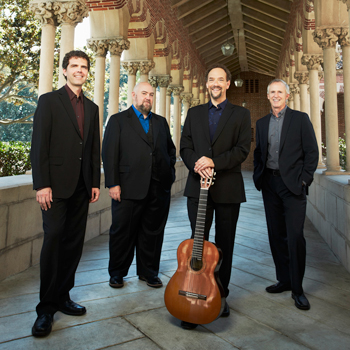by Robert Rollin

Beaser treats the theme — based on an extended chord progression, and sometimes appearing in the guise of a Baroque ground bass — to a lively set of contrasting variations. After a stolid, duple introduction, several accelerandos add excitement.
Soon a syncopated, triple-metered variation ensues, treated with flexible tempo and expressive nuance by the Quartet. The return to duple meter comes with a repeating rhythmic pattern, canonic entrances tossed among the players, and dissolution to silence. Next, free recitative-like rhythm joins with percussive thumb-tapping.
Beautiful doubled lines added emphasis and color when the duple meter once again resumed. A final Argentine tango variation sparkled with meticulous ensemble. Beaser’s own musical palette absorbed the stylistic mélange beautifully.
Pat Metheny’s Road to the Sun, also written for the group, came about after the Quartet encountered the guitarist/composer at a festival in Montana, and after Metheny took the road called Going to the Sun to visit Glacier National Park. The composer calls the resultant 25-minute, 6-section piece not a depiction of that road, but rather “an emotional journey.”
Section 1 begins with experimental-sounding tremolo figures in two guitars, soon segueing to eighth-notes punctuated by triplet cross-rhythms, and closing with blatant forte dynamics.
After a softer second section introduces whole-tone melodies, a faster third provides contrast with Metheny’s signature ostinato grooves. The fourth resembles electronic music, with twitters and bleeps generated by string rubbing and playing behind the bridge.
Section 5 reintroduces the triplet figures underlined by percussive effects. The final section, slow and modal-sounding, returns to the tremolos and fades gently to silence. The audience reacted with thunderous applause and a standing ovation.
The program also featured transcriptions, including Rossini’s Overture to The Barber of Seville, selections from Bizet’s Carmen, and Thomas Morley’s First Booke of Consort-Lessons. The ever-popular Rossini absolutely scintillated with rapid tremolo strumming, near-perfect ensemble, and wondrously dramatic dynamic contrasts.
The players approximated the sound of castanets in Carmen’s “Aragonaise” by gently tapping their fingernails on the sides of the guitars. A graceful solo enriched the “Habanera,” and the “March of the Toreadors” shone with powerful dynamics. The “Gypsy Dance” began softly and accelerated to a fiery close.
English Renaissance composer Morley collected the hits of his day in his First Booke. Tunes arranged by Byrd, Dowland, Allison, and Morley glittered in the group’s superlative performances.
Published on ClevelandClassical.com November 12, 2018.
Click here for a printable copy of this article



